Lexus IS300h 2017 Owner's Manual
Manufacturer: LEXUS, Model Year: 2017, Model line: IS300h, Model: Lexus IS300h 2017Pages: 692, PDF Size: 163.7 MB
Page 211 of 692
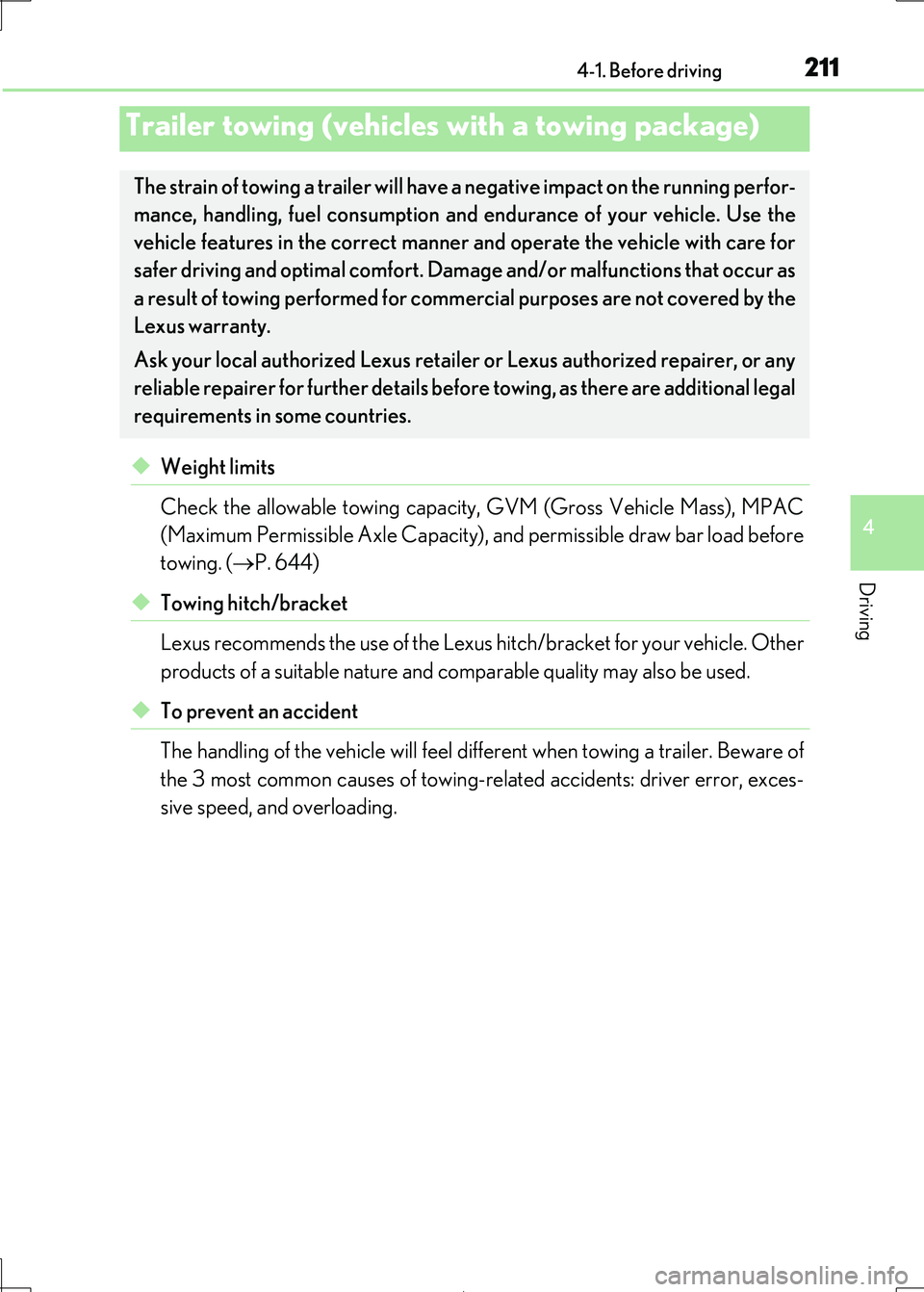
2114-1. Before driving
4
Driving
IS300h_EE(OM53D89E)
◆Weight limits
Check the allowable towing capacity, GVM (Gross Vehicle Mass), MPAC
(Maximum Permissible Axle Capacity), and permissible draw bar load before
towing. ( P. 644)
◆Towing hitch/bracket
Lexus recommends the use of the Lexus hi tch/bracket for your vehicle. Other
products of a suitable nature and comparable quality may also be used.
◆To prevent an accident
The handling of the vehicle will feel diff erent when towing a trailer. Beware of
the 3 most common causes of towing-rel ated accidents: driver error, exces-
sive speed, and overloading.
Trailer towing (vehicles with a towing package)
The strain of towing a trailer will have a negative impact on the running perfor-
mance, handling, fuel consumption and endurance of your vehicle. Use the
vehicle features in the correct manner and operate the vehicle with care for
safer driving and optimal comfort. Dama ge and/or malfunctions that occur as
a result of towing performed for comme rcial purposes are not covered by the
Lexus warranty.
Ask your local authorized Lexus retailer or Lexus authorized repairer, or any
reliable repairer for furthe r details before towing, as there are additional legal
requirements in some countries.
Page 212 of 692
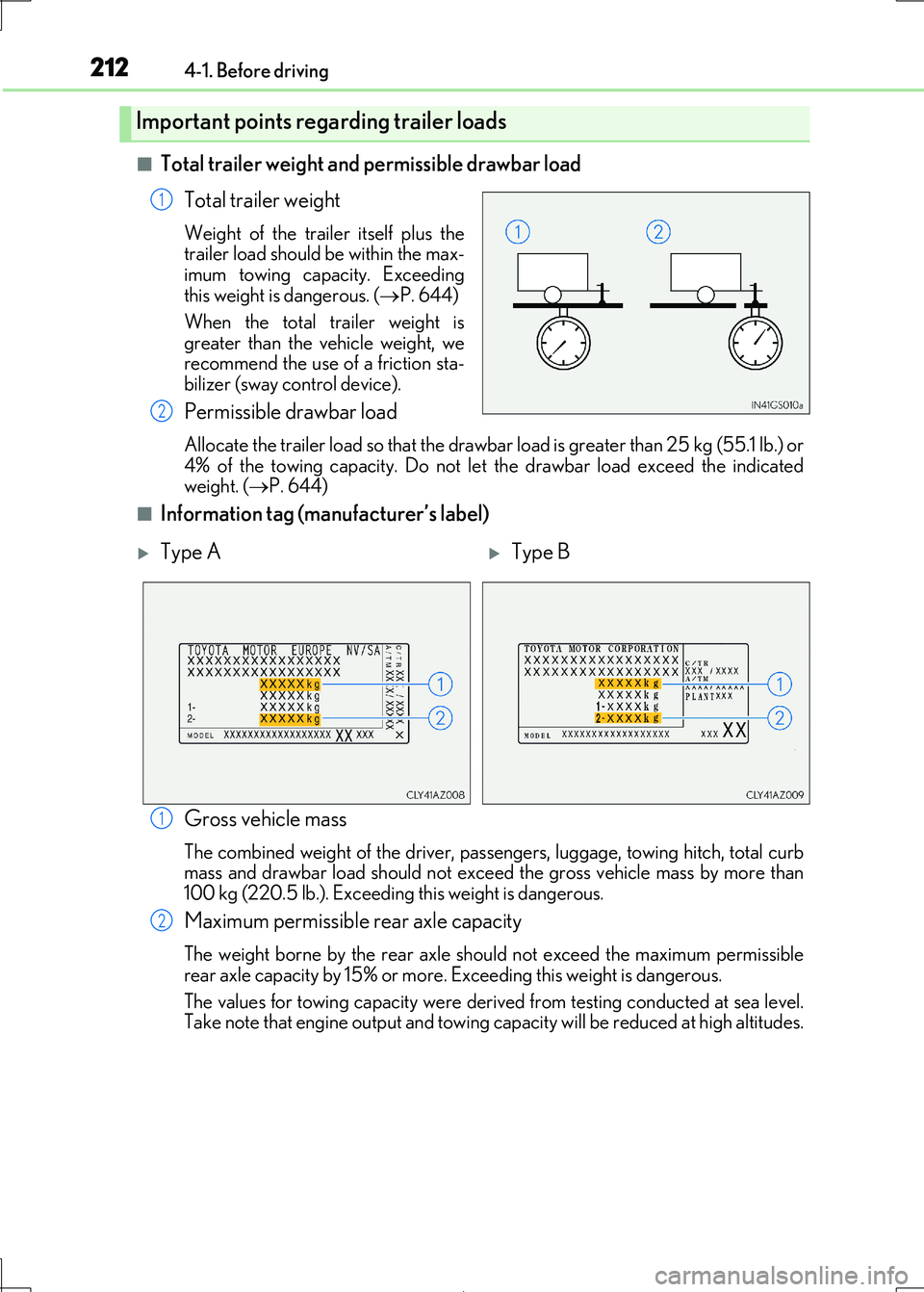
2124-1. Before driving
IS300h_EE(OM53D89E)
■Total trailer weight and permissible drawbar load
Total trailer weight
Weight of the traile r itself plus the trailer load should be within the max-
imum towing capacity. Exceeding
this weight is dangerous. ( P. 644)
When the total trailer weight is
greater than the vehicle weight, we
recommend the use of a friction sta- bilizer (sway control device).
Permissible drawbar load
Allocate the trailer load so that the drawba r load is greater than 25 kg (55.1 lb.) or
4% of the towing capacity. Do not let the drawbar load exceed the indicated weight. ( P. 644)
■Information tag (manufacturer’s label)
Gross vehicle mass
The combined weight of the driver, passengers, luggage, towing hitch, total curb
mass and drawbar load should not exceed the gross vehicle mass by more than
100 kg (220.5 lb.). Exceedin g this weight is dangerous.
Maximum permissible rear axle capacity
The weight borne by the rear axle should not exceed the maximum permissible
rear axle capacity by 15% or more. Exceeding this weight is dangerous.
The values for towing capacity were derived from testing conducted at sea level. Take note that engine output and towing capacity will be reduced at high altitudes.
Important points regarding trailer loads
1
2
Type AType B
1
2
Page 213 of 692
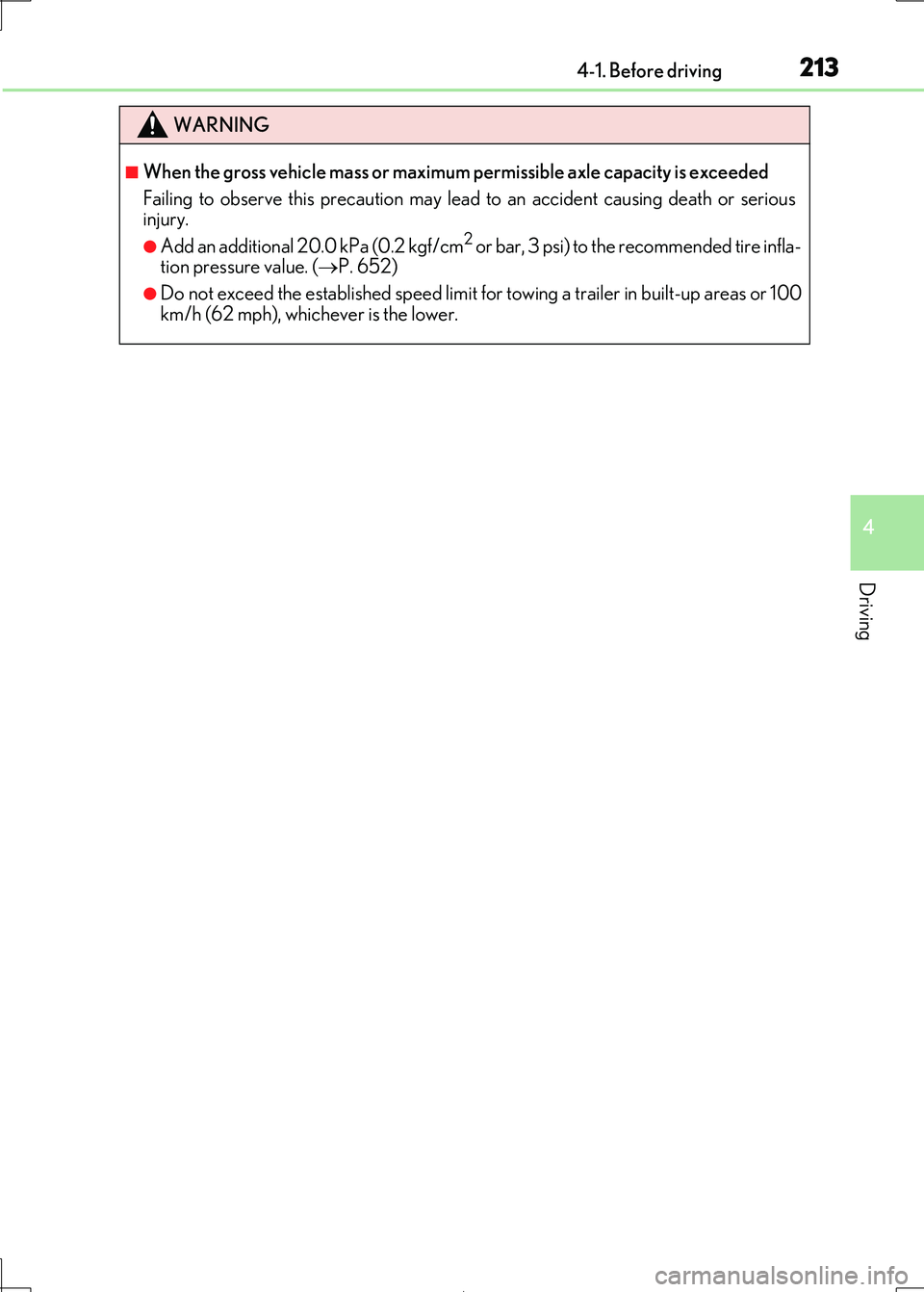
2134-1. Before driving
4
Driving
IS300h_EE(OM53D89E)
WARNING
■When the gross vehicle mass or maximum permissible axle capacity is exceeded
Failing to observe this precau tion may lead to an accident causing death or serious
injury.
●Add an additional 20.0 kPa (0.2 kgf/cm2 or bar, 3 psi) to the recommended tire infla- tion pressure value. ( P. 652)
●Do not exceed the established speed limit for towing a trailer in built-up areas or 100
km/h (62 mph), whic hever is the lower.
Page 214 of 692
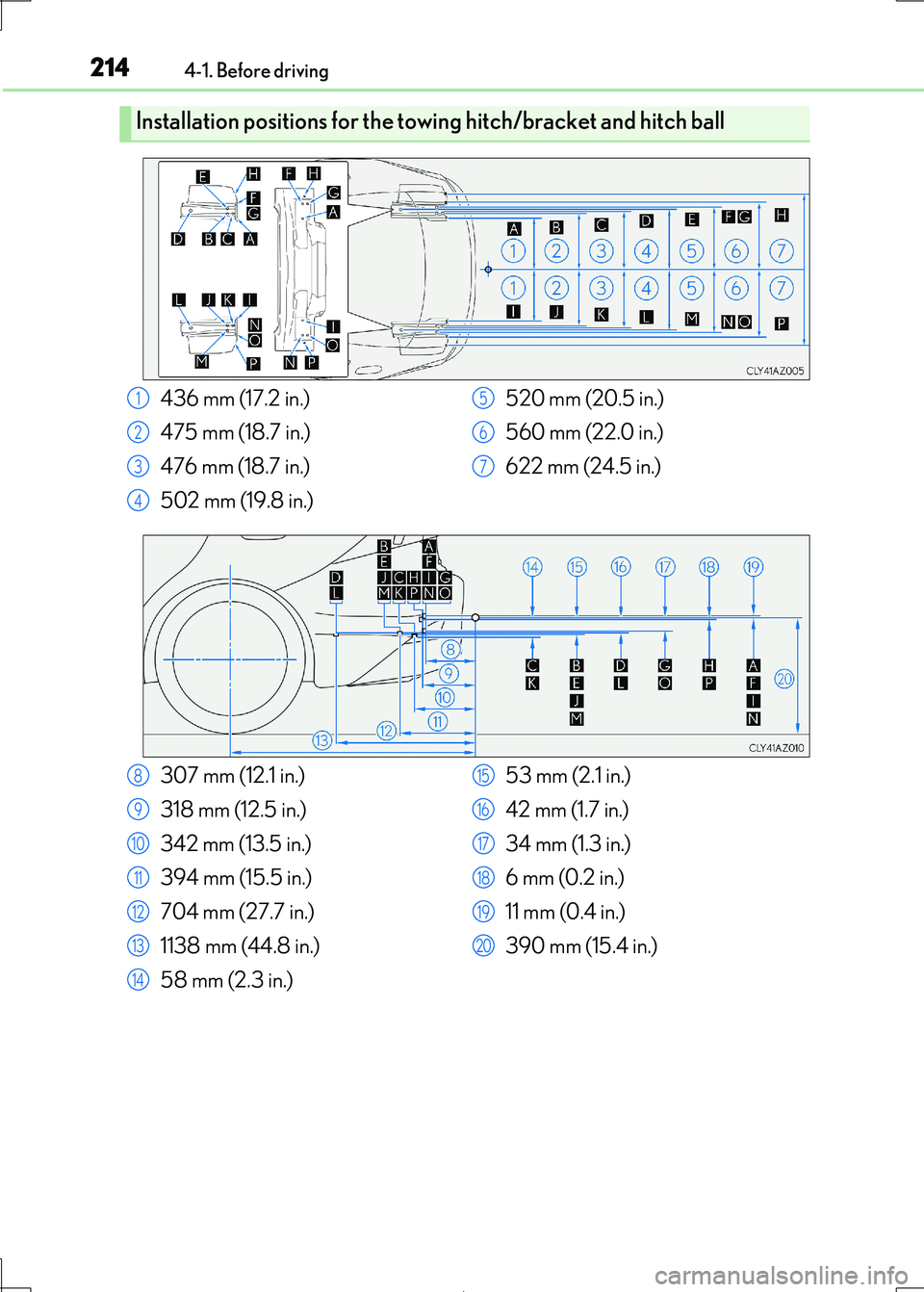
2144-1. Before driving
IS300h_EE(OM53D89E)
Installation positions for the towing hitch/bracket and hitch ball
436 mm (17.2 in.)
475 mm (18.7 in.)
476 mm (18.7 in.)
502 mm (19.8 in.)
520 mm (20.5 in.)
560 mm (22.0 in.)
622 mm (24.5 in.)
1
2
3
4
5
6
7
307 mm (12.1 in.)
318 mm (12.5 in.)
342 mm (13.5 in.)
394 mm (15.5 in.)
704 mm (27.7 in.)
1138 mm (44.8 in.)
58 mm (2.3 in.)
53 mm (2.1 in.)
42 mm (1.7 in.)
34 mm (1.3 in.)
6 mm (0.2 in.)
11 mm (0.4 in.)
390 mm (15.4 in.)
8
9
10
11
12
13
14
15
16
17
18
19
20
Page 215 of 692
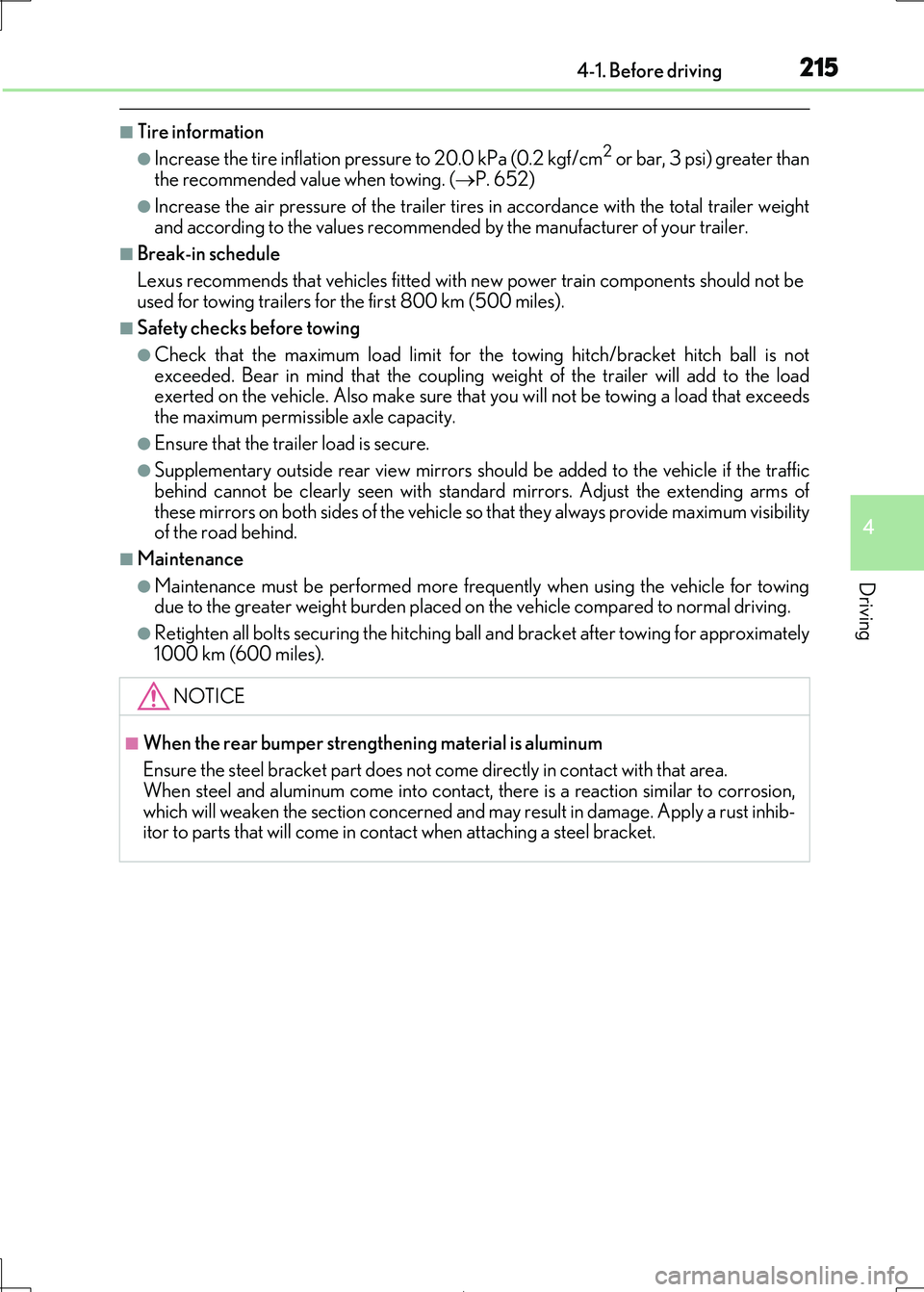
2154-1. Before driving
4
Driving
IS300h_EE(OM53D89E)
■Tire information
●Increase the tire inflation pressure to 20.0 kPa (0.2 kgf/cm2 or bar, 3 psi) greater than
the recommended value when towing. ( P. 652)
●Increase the air pressure of the trailer tires in accordance with the total trailer weight
and according to the values recommended by the manufacturer of your trailer.
■Break-in schedule
Lexus recommends that vehicles fitted with new power train components should not be
used for towing trailers for the first 800 km (500 miles).
■Safety checks before towing
●Check that the maximum load limit for the towing hitch/bracket hitch ball is not
exceeded. Bear in mind that the coupling weight of the trailer will add to the load
exerted on the vehicle. Also make sure that you will not be towing a load that exceeds the maximum permissible axle capacity.
●Ensure that the trailer load is secure.
●Supplementary outside rear view mirrors shou ld be added to the vehicle if the traffic behind cannot be clearly seen with standa rd mirrors. Adjust the extending arms of
these mirrors on both sides of the vehicle so that they always provide maximum visibility
of the road behind.
■Maintenance
●Maintenance must be performed more frequently when using the vehicle for towing
due to the greater weight burden placed on the vehicle compared to normal driving.
●Retighten all bolts securing the hitching ball and bracket after towing for approximately
1000 km (600 miles).
NOTICE
■When the rear bumper strengthening material is aluminum
Ensure the steel bracket part does not come directly in contact with that area.
When steel and aluminum come into contact, there is a reaction similar to corrosion,
which will weaken the section concerned and may result in damage. Apply a rust inhib- itor to parts that will come in contact when attaching a steel bracket.
Page 216 of 692
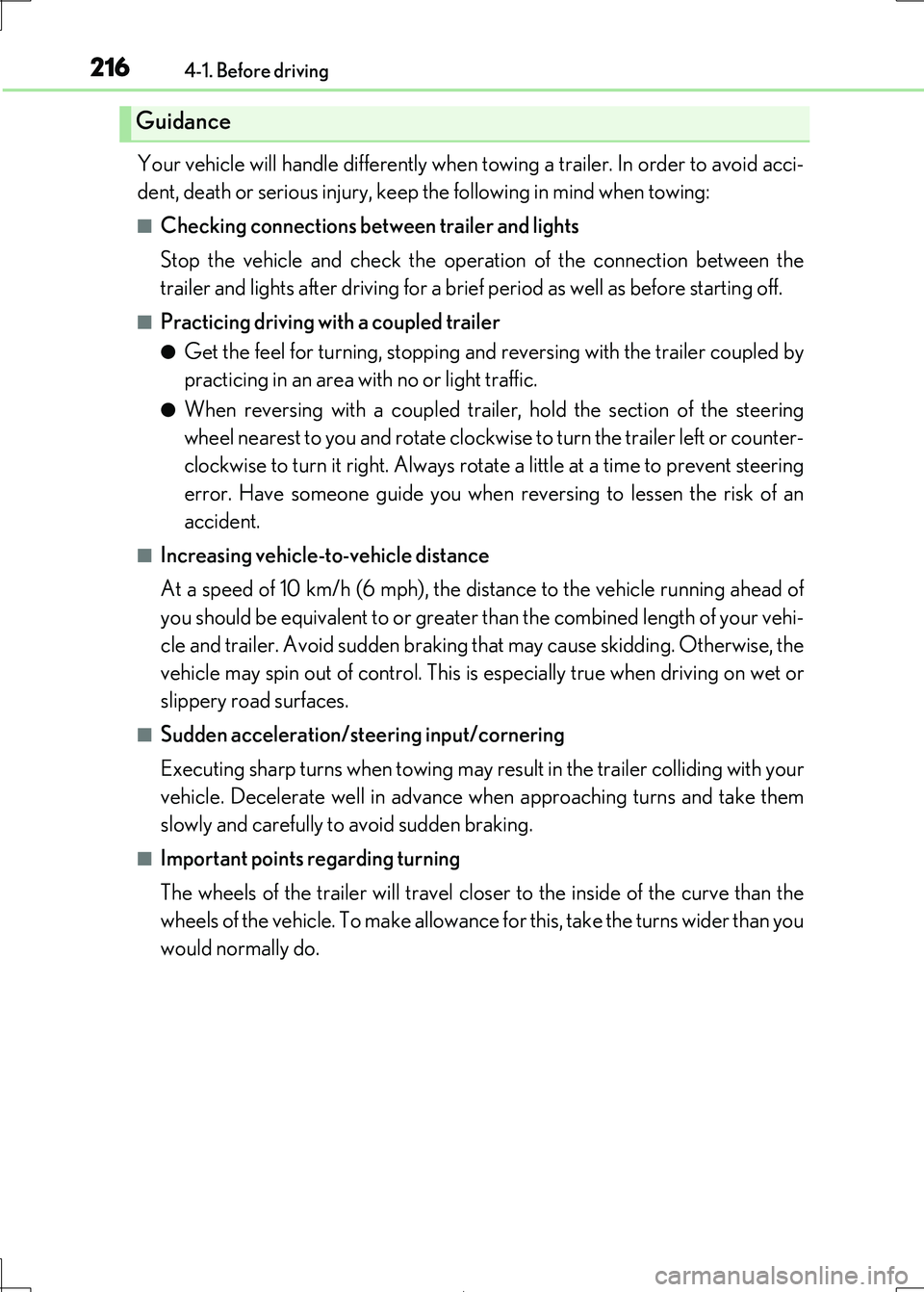
2164-1. Before driving
IS300h_EE(OM53D89E)
Your vehicle will handle differently when towing a trailer. In order to avoid acci-
dent, death or serious injury, keep the following in mind when towing:
■Checking connections between trailer and lights
Stop the vehicle and check the operation of the connection between the
trailer and lights after driving for a brief period as well as before starting off.
■Practicing driving with a coupled trailer
●Get the feel for turning, stopping and reversing with the trailer coupled by
practicing in an area with no or light traffic.
●When reversing with a coupled traile r, hold the section of the steering
wheel nearest to you and rotate clockwis e to turn the trailer left or counter-
clockwise to turn it right. Always rotate a little at a time to prevent steering
error. Have someone guide you when reversing to lessen the risk of an
accident.
■Increasing vehicle-to-vehicle distance
At a speed of 10 km/h (6 mph), the di stance to the vehicle running ahead of
you should be equivalent to or greater than the combined length of your vehi-
cle and trailer. Avoid sudden braking th at may cause skidding. Otherwise, the
vehicle may spin out of control. This is especially true when driving on wet or
slippery road surfaces.
■Sudden acceleration/steering input/cornering
Executing sharp turns when towing may re sult in the trailer colliding with your
vehicle. Decelerate well in advance when approaching turns and take them
slowly and carefully to avoid sudden braking.
■Important points regarding turning
The wheels of the trailer will travel closer to the inside of the curve than the
wheels of the vehicle. To make allowance for this, take the turns wider than you
would normally do.
Guidance
Page 217 of 692
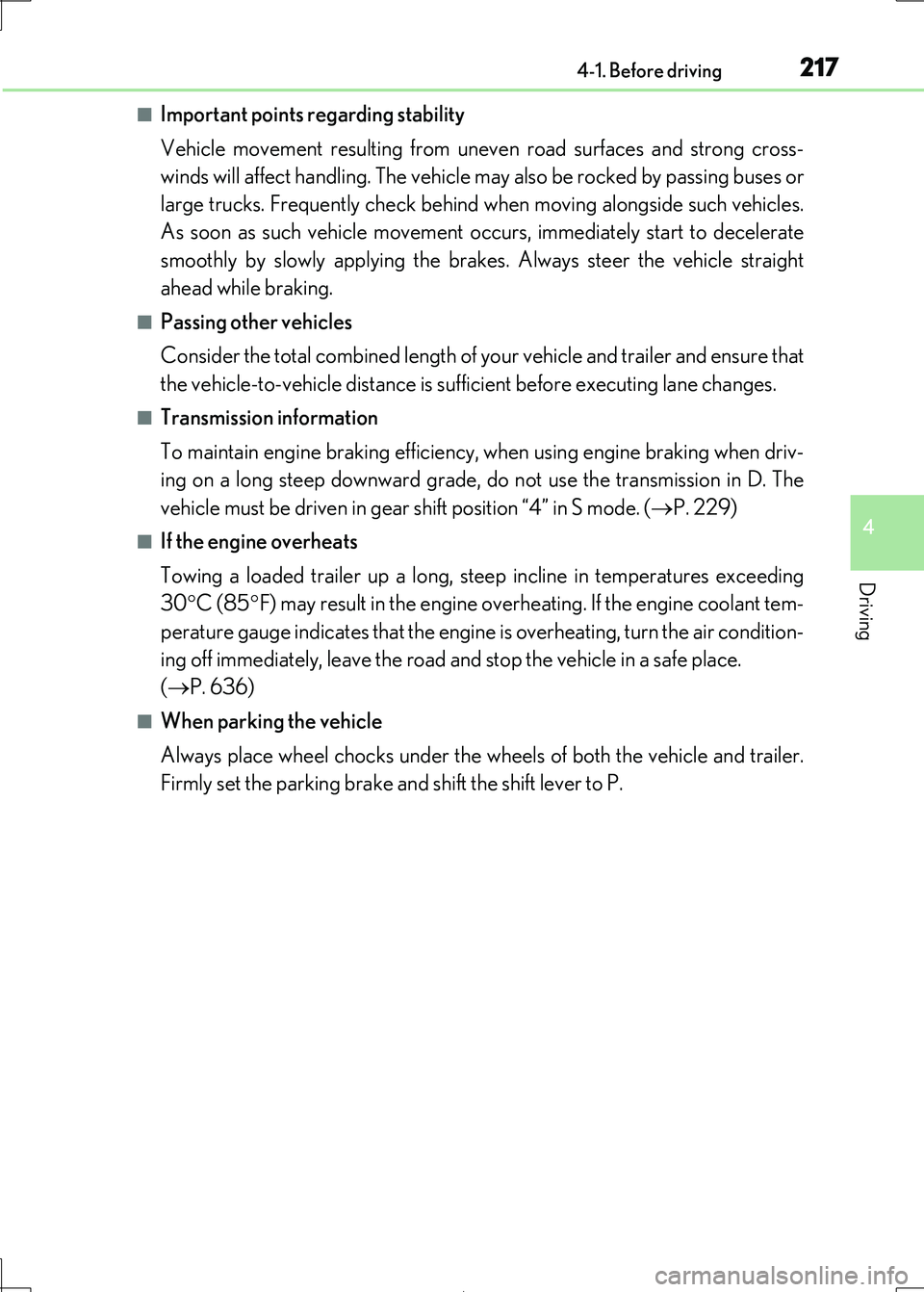
2174-1. Before driving
4
Driving
IS300h_EE(OM53D89E)
■Important points regarding stability
Vehicle movement resulting from unev en road surfaces and strong cross-
winds will affect handling. The vehicle ma y also be rocked by passing buses or
large trucks. Frequently check behind when moving alongside such vehicles.
As soon as such vehicle movement o ccurs, immediately start to decelerate
smoothly by slowly applying the brakes. Always steer the vehicle straight
ahead while braking.
■Passing other vehicles
Consider the total combined length of your vehicle and trailer and ensure that
the vehicle-to-vehicle distance is su fficient before executing lane changes.
■Transmission information
To maintain engine braking efficiency, when using engine braking when driv-
ing on a long steep downward grade, do not use the transmission in D. The
vehicle must be driven in gear shift position “4” in S mode. (P. 229)
■If the engine overheats
Towing a loaded trailer up a long, steep incline in temperatures exceeding
30 C (85F) may result in the engine overheating. If the engine coolant tem-
perature gauge indicates that the engine is overheating, turn the air condition-
ing off immediately, leave the road and stop the vehicle in a safe place.
( P. 636)
■When parking the vehicle
Always place wheel chocks under the wheels of both the vehicle and trailer.
Firmly set the parking brake an d shift the shift lever to P.
Page 218 of 692
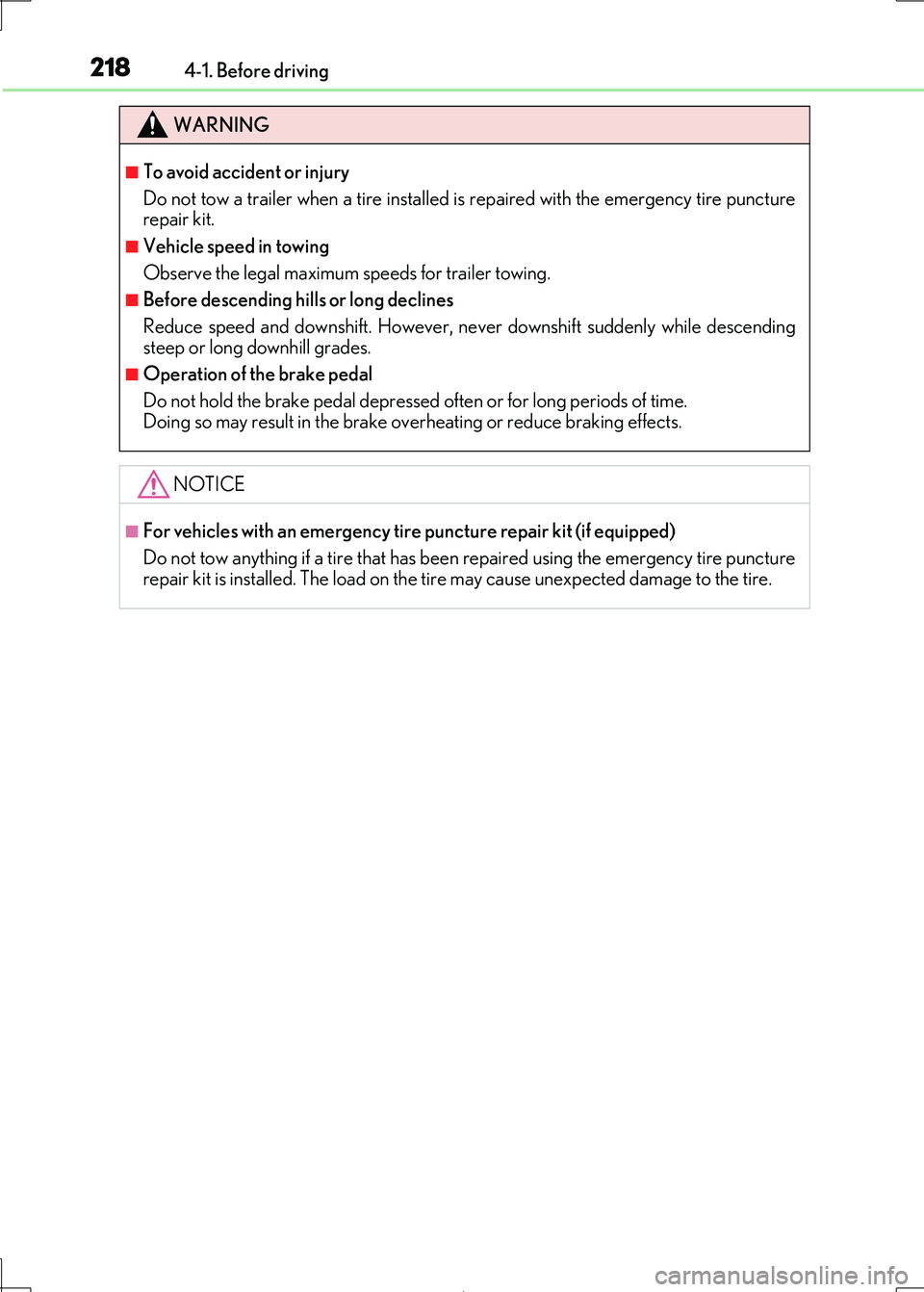
2184-1. Before driving
IS300h_EE(OM53D89E)
WARNING
■To avoid accident or injury
Do not tow a trailer when a tire installed is repaired with the emergency tire puncture
repair kit.
■Vehicle speed in towing
Observe the legal maximum speeds for trailer towing.
■Before descending hills or long declines
Reduce speed and downshift. However, never downshift suddenly while descending steep or long downhill grades.
■Operation of the brake pedal
Do not hold the brake pedal depressed often or for long periods of time. Doing so may result in the brake ov erheating or reduce braking effects.
NOTICE
■For vehicles with an emergency tire puncture repair kit (if equipped)
Do not tow anything if a tire that has been repaired using the emergency tire puncture
repair kit is installed. The load on the ti re may cause unexpected damage to the tire.
Page 219 of 692
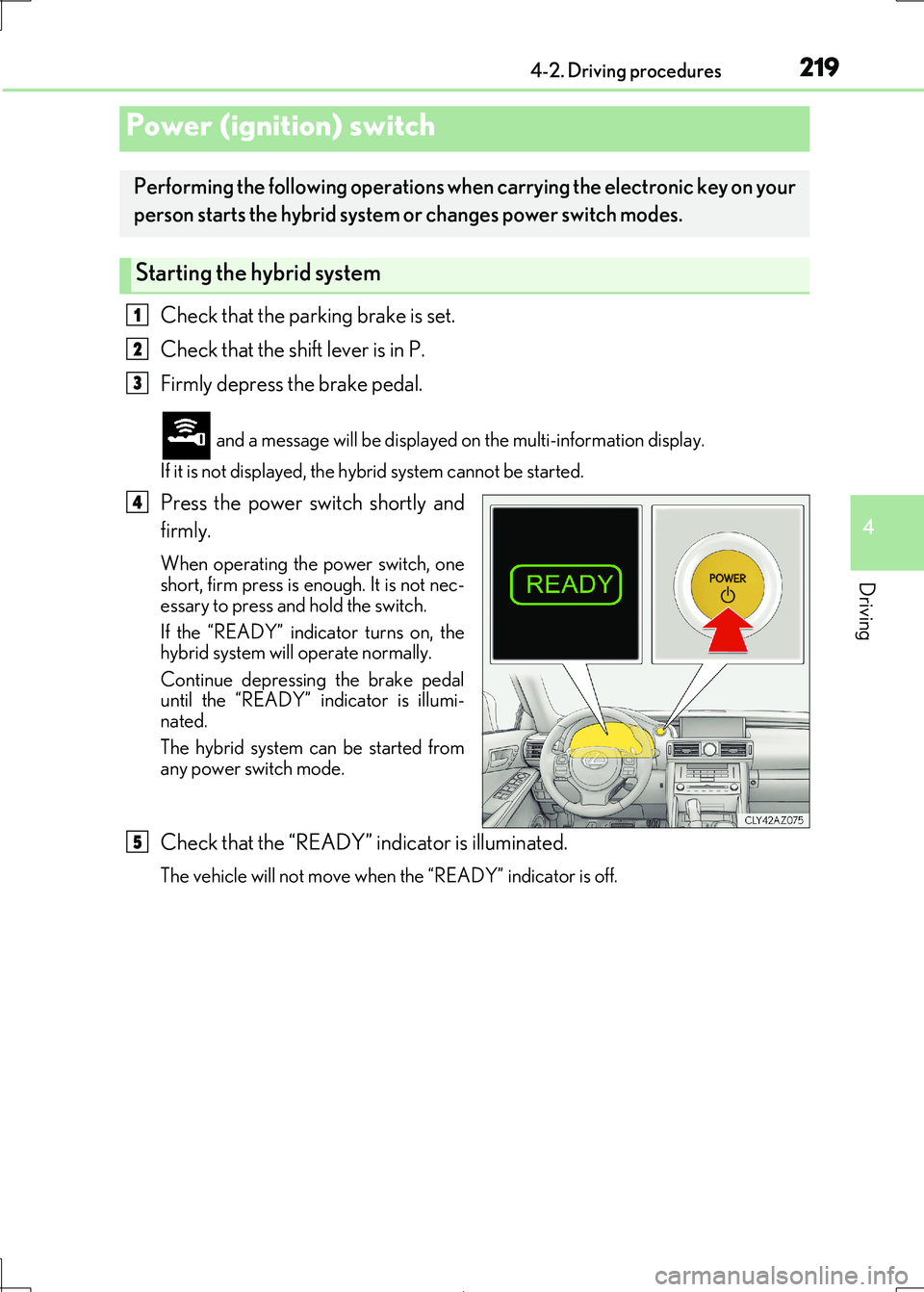
219
4
Driving
IS300h_EE(OM53D89E)
4-2. Driving procedures
Check that the parking brake is set.
Check that the shift lever is in P.
Firmly depress the brake pedal.
and a message will be displayed on the multi-information display.
If it is not displayed, the hybrid system cannot be started.
Press the power switch shortly and
firmly.
When operating the power switch, one short, firm press is enough. It is not nec-
essary to press and hold the switch.
If the “READY” indicator turns on, the hybrid system will operate normally.
Continue depressing the brake pedal
until the “READY” indicator is illumi-
nated.
The hybrid system can be started from
any power switch mode.
Check that the “READY” indicator is illuminated.
The vehicle will not move when the “READY” indicator is off.
Power (ignition) switch
Performing the following operations when carrying the electronic key on your
person starts the hybrid system or changes power switch modes.
Starting the hybrid system
1
2
3
4
5
Page 220 of 692
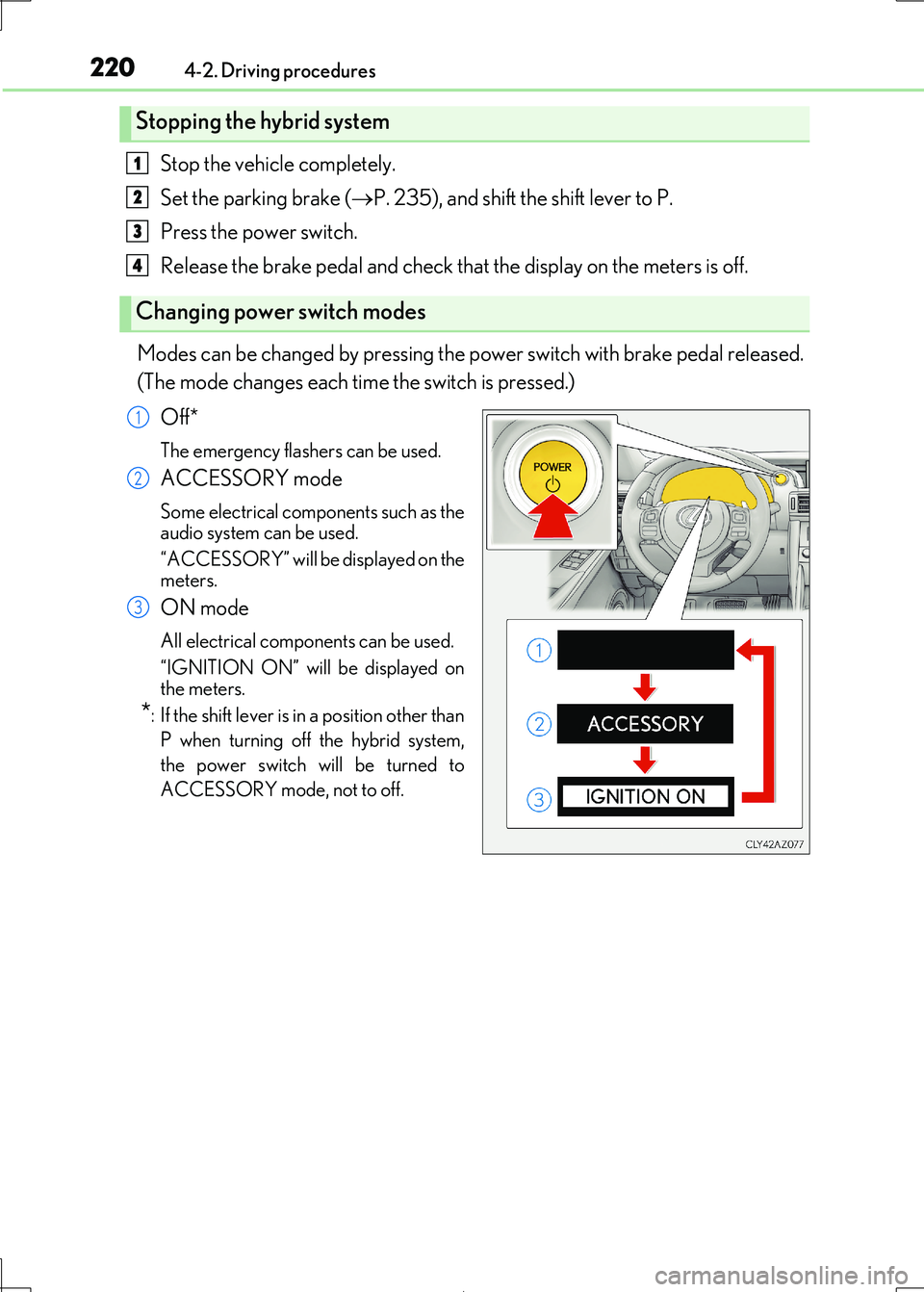
2204-2. Driving procedures
IS300h_EE(OM53D89E)
Stop the vehicle completely.
Set the parking brake ( P. 235), and shift the shift lever to P.
Press the power switch.
Release the brake pedal and check that the display on the meters is off.
Modes can be changed by pressing the power switch with brake pedal released.
(The mode changes each time the switch is pressed.)
Off*
The emergency flashers can be used.
ACCESSORY mode
Some electrical components such as the audio system can be used.
“ACCESSORY” will be displayed on the
meters.
ON mode
All electrical components can be used.
“IGNITION ON” will be displayed on
the meters.
*: If the shift lever is in a position other than
P when turning off the hybrid system,
the power switch will be turned to
ACCESSORY mode, not to off.
Stopping the hybrid system
Changing power switch modes
1
2
3
4
1
2
3